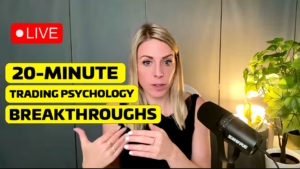Have you ever been there?
One moment, you’re a disciplined trader. The next, it feels like a stranger—some trade-hungry addict—has hijacked your trading account.
You only snap out of it after you’ve blown past your daily loss limit and put a serious dent in your capital.
This is trading on tilt, and it’s more common than you think.
But common doesn’t make it harmless. Repeating this pattern over weeks or months can devastate your trading account—and your confidence.
In this article, I’ll break down the root causes of trading on tilt and share 5 practical tips to stop it for good.
Let’s dive in.
Why Trading On Tilt Happens
When you’re trading on tilt, your subconscious mind takes control, leaving your conscious mind checked out.
This happens due to four factors working together:
- Increased Pressure:
- Tilt often follows a series of losses—or even wins.
- The pressure to “win back” losses or lock in unrealized gains can push you into irrational decisions.
- Heightened Emotions:
- Pressure triggers emotions like frustration, anger, fear, or greed.
- These emotions overwhelm your rational mind, leading to impulsive trades.
- Subconscious Programming:
- Limiting beliefs—like a scarcity mindset or tying self-worth to P&L—add extra emotional weight and pressure to your trading results.
- Dissociation:
- Under stress, you “numb out,” operating on autopilot so that you don’t have to sit with the discomfort of losses or uncertainty.
- This disconnect fuels reckless trades, as you chase relief instead of rationality.
Understanding these factors is the first step to breaking the tilt cycle.
5 Tips to Resolve Trading on Tilt
Resolving trading on tilt is simply a matter of addressing some or all of these four factors to reduce their intensity or impact so that your conscious mind can stay in control of your trading.
Here are five actionable strategies to regain control and protect your account:
1. Name the emotions you are feeling.
Research shows that simply the act of labelling your emotions can reduce the intensity of them. By naming out loud or on paper the emotions that you are feeling in the moment as you trade, you lessen the emotional charge and also disrupt the automatic process of your subconscious mind taking over your trading. It gives your conscious mind that split-second window to regain control.
2. Journal after every trade (win or lose).
Write down the emotions you were feeling before every single trade. Then note down whether you stuck to your trading plan or whether you broke your own rules. If you didn’t stick to your plan, note down the exact action that you took that was a deviation from your rules (e.g. ignored my stop, took a low-quality set up that wasn’t in my trade book).
By tracking this data you will develop much better conscious awareness of your own patterns of self-sabotage—allowing you to intervene more quickly when things start to go off-track.
3. Practice deep breathing or simple relaxation techniques while you trade.
Use simple breathing or in-the-moment relaxation techniques to reduce the level of pressure and stress you are under while trading.
Research shows that reducing either physical tension or cognitive worry can be sufficient to help you withstand the catastrophic effects of pressure on performance. If pressure lessens, then it’s likely that the effects of the other three factors may not be intense enough to trigger trading on tilt.
You can also work on your resilience to pressure away from the trading desk. Try this Profit From Pressure guided visualisation to help you reframe your relationship with pressure and become immune to the effects of pressure on your trading performance.
4. Hold yourself accountable to the execution of your trading plan
Focusing on the PNL and the outcome of a trade actually heightens pressure. To reduce pressure and promote better discipline and consistency, set performance-based goals that hold you accountable to the execution of your trading plan as opposed to the PNL.
By measuring success in terms of, for example, the percentage of trades you took that met your A+ setup criteria, you can decrease the likelihood of going on tilt.
5. Create a Decision-Tree.
This is a simple emergency plan of action that you create away from the trading desk and then implement in your trading any time you feel the urge to start trading on tilt. Choose a specific, measurable trigger that activates your decision-tree plan. This could be taking three losses in a row or when your anger reaches an intensity of 6/10 or higher—any event that you know usually leads to your trading on tilt.
Then plan a series of actions that you will take to act as a circuit-breaker to help you stay present and connected with your mind and body. These actions could be as simple as doing your deep breathing exercises or stepping away from the computer screen for 5 minutes and having a cup of tea or taking a walk around the block. The aim is to stop the dissociation from taking hold, allowing you to remain in the driver’s seat of your trading.
The Bottom Line
Trading on tilt is destructive, but it’s not permanent.
By understanding the root causes and implementing these strategies, you can reclaim control and preserve your account.
It won’t happen overnight—you’re rewiring a lifetime of programming—but with persistence, you can break free.
What’s your first step to trading with discipline today?
Next Steps
Ready to build unbreakable trading psychology and take your trading to the level where discipline, consistency and elite-execution become second-nature?
My Go Deep to Level Up Your Trading™ program has helped professional and aspiring professional traders eliminate self-sabotage and develop elite-level execution — without relying on mindset hacks or willpower.
It’s designed specifically for experienced traders who are ready to evolve beyond surface-level mindset tips and build a system for mental and emotional mastery. Click here to learn more and enrol for instant access.
Not ready for the full program yet? start with my free Trading Psychology Intensive training — it’s the perfect way to start your journey to building a razor-sharp mental edge. Get instant access here.










